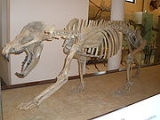
Amphicyon
Overview
Genus
In biology, a genus is a low-level taxonomic rank used in the biological classification of living and fossil organisms, which is an example of definition by genus and differentia...
of large carnivorous bone-crushing mammal
Mammal
Mammals are members of a class of air-breathing vertebrate animals characterised by the possession of endothermy, hair, three middle ear bones, and mammary glands functional in mothers with young...
s, known as bear-dogs, of the family Amphicyonidae, subfamily Amphicyoninae
Amphicyoninae
Amphicyoninae is a subfamily of extinct Amphicyonidae, large terrestrial carnivores belonging to the suborder Caniformia and which inhabited North America, Europe, Eurasia, Asia. and Africa from ~22.4—4.9 Ma. Amphicyoninae existed for approximately ~.Amphicyoninae was named by Trouessart...
, from the Aquitanian
Aquitanian
Aquitanian could refer to:*Aquitanian age, a geological age, the first stage of the Miocene Epoch*Aquitanian language, an ancient language spoken in the region later known as Gascony* Anything originating from Aquitaine, a region of France....
Epoch until the Tortonian
Tortonian
The Tortonian is in the geologic timescale an age or stage of the late Miocene that spans the time between 11.608 ± 0.005 Ma and 7.246 ± 0.005 Ma . It follows the Serravallian and is followed by the Messinian....
. They ranged over North America
North America
North America is a continent wholly within the Northern Hemisphere and almost wholly within the Western Hemisphere. It is also considered a northern subcontinent of the Americas...
, Europe
Europe
Europe is, by convention, one of the world's seven continents. Comprising the westernmost peninsula of Eurasia, Europe is generally 'divided' from Asia to its east by the watershed divides of the Ural and Caucasus Mountains, the Ural River, the Caspian and Black Seas, and the waterways connecting...
, Asia
Asia
Asia is the world's largest and most populous continent, located primarily in the eastern and northern hemispheres. It covers 8.7% of the Earth's total surface area and with approximately 3.879 billion people, it hosts 60% of the world's current human population...
, and Africa
Africa
Africa is the world's second largest and second most populous continent, after Asia. At about 30.2 million km² including adjacent islands, it covers 6% of the Earth's total surface area and 20.4% of the total land area...
from 20.6—9 Ma ago, existing approximately .
Amphicyon was the typical bear-dog amphicyonid with morphology similar to both bears and dogs. With its robust build and maximum length of 2.5 m (8 ft), the largest species looked more like a bear
Bear
Bears are mammals of the family Ursidae. Bears are classified as caniforms, or doglike carnivorans, with the pinnipeds being their closest living relatives. Although there are only eight living species of bear, they are widespread, appearing in a wide variety of habitats throughout the Northern...
than a dog
Dog
The domestic dog is a domesticated form of the gray wolf, a member of the Canidae family of the order Carnivora. The term is used for both feral and pet varieties. The dog may have been the first animal to be domesticated, and has been the most widely kept working, hunting, and companion animal in...
.

